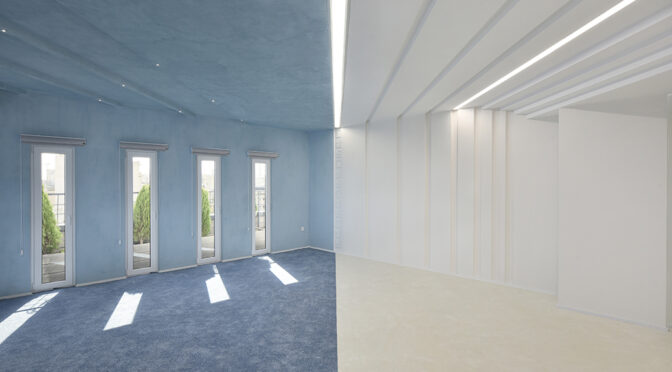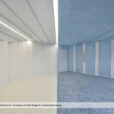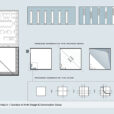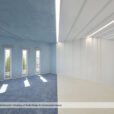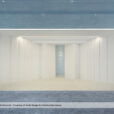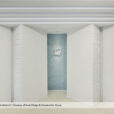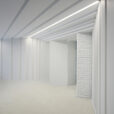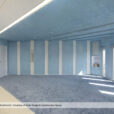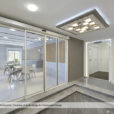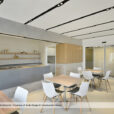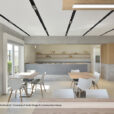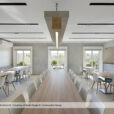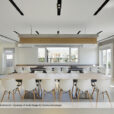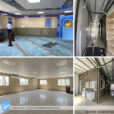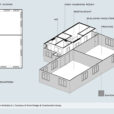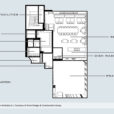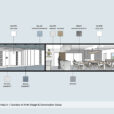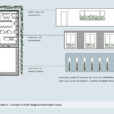مجموعه خدماتی شرکت راهسازی و عمران ایران
شرکت آروین (الهام فرخی)
موقعیت: تهران، ایران
تاریخ: ۱۴۰۰
مساحت: ۲۰۰ مترمربع
وضعیت: ساختهشده
کارفرما: شرکت راهسازی و عمران ایران
مدیر اجرایی: ناصر هاشمی
تیم اجرایی: ابوالفضل محمدزاده
گرافیک: فاطمه قنبری
عکس: استودیو دید
هر پروژه با تعاریف و چالشهای خاص خود، تجربهای متفاوت برای دفتر جوان ما رقم میزند. موقعیت و بستر، خواستههای کارفرما، کاربری، محدودیتهای فضایی و زمانی، بودجه، و بسیاری از عوامل بیرونی، همگی اثر مستقیم خود را بر یک پروژه اعمال میکنند؛ اما چگونگی ایجاد تعادل بین تمامی عوامل بیرونی اثرگذار و اهداف دفتر ما بهعنوان طراح و مجری، همواره یکی از دغدغههای اصلی ما در هر پروژه است. پروژه خدماتی ساختمان مرکزی شرکت راهسازی و عمران ایران نیز یکی از پروژههایی است که در این مسیر حرکت میکند، و شاید در میان تمامی تجربههایمان، برقراری تعادل میان عوامل بیرونی و اهداف تیم ما، در این پروژه بیشتر به چشم میخورد.
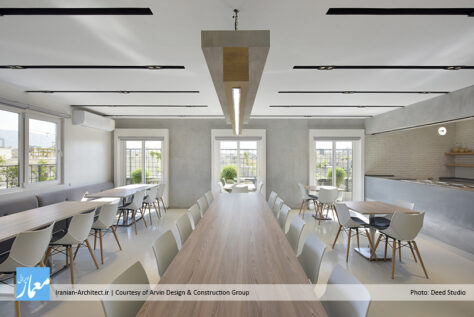
مجموعه خدماتی شرکت راهسازی و عمران ایران در طبقه ششم یک ساختمان اداری فعال در خیابان بهشتی واقع شده است. این طبقه شامل سالن غذاخوری و نمازخانه، هرکدام با ظرفیت حدود ۵۰ نفر، دو چشمه سرویس بهداشتی، وضوخانه، لابی و انباری است. درخواست کارفرما مبنی بر طراحی داخلی و نوسازی این مجموعه با تاکید بر روحبخشیدن به فضای استراحت کارکنان، هماهنگی با ساختارهای درونسازمانی و پیروی از ضوابط، و کمترین میزان خلل در سازوکار اداری طبقات دیگر و رفتوآمدهای روزانه، در زمان فرایند عملیات اجرایی بود.
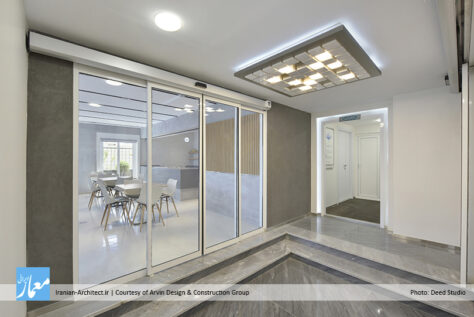
در پلان پیشین مجموعه، نمازخانه در جبهه شمالی بنا، و سالن غذاخوری در جبهه جنوبی قرار داشت که با توجه به جهت قبله در نمازخانه و دسترسی به آن، راهرویی طویل ارتباط بین فضاها را امکانپذیر کرده بود. راهروی موجود ضمن داشتن کیفیت فضایی نامطلوب، مساحت زیادی را نیز به خود اختصاص داده بود. از طرف دیگر، قرارگیری سالن غذاخوری در جبهه جنوبی بنا و داشتن بازشوهایی با چشمانداز نامناسب به بام و تاسیسات ساختمان مجاور، و نیز فاصله آن با اتاق ظرفشویی، نیاز به بازنگری در طراحی داشت. همچنین الزاماتی چون داشتن دو دسترسی اصلی از شمال و جنوب به بام، حفظ مساحتهای لازم برای هر فضا با توجه به خواسته کارفرما، و دسترسی به اتاق تاسیسات، محدودیتهای خود را اعمال میکرد. بنابراین اولین گام در طراحی فضای داخلی، چینش مجدد فضاها و ساماندهی آنها بود. در نتیجه، با جابهجایی نمازخانه و سالن غذاخوری، دسترسی مناسبتر به نمازخانه، و چشمانداز زیباتر به سمت کوههای شمالی تهران، در سالن غذاخوری حاصل شد. لابی ورودی نیز با قرارگیری در مجاورت آسانسور، دسترسی به سایر فضاها را با مساحت و هندسهای مناسبتر فراهم آورد. در انتها نیز سرویس بهداشتی با توجه به محدودیت تاسیسات، در میانه این دو فضا، و در مجاورت نمازخانه جای داده شد.
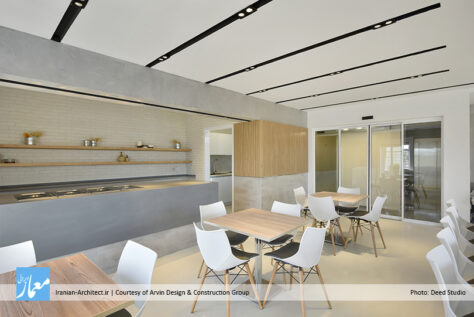
پس از تثبیت جانماییهای اصلی، ریزفضاهای لازم به تناسب عملکرد هریک از فضاها تعریف شدند. در سالن غذاخوری، با توجه به اینکه عملیات پخت در آن انجام نمیشد، مساحت لازم برای آشپزخانهای با امکانات مختصر جهت آمادهسازی غذا، شامل اتاق ظرفشویی، کانتر گرم، یخچال و باکسهای ذخیره، برنامهریزی شد. در نمازخانه نیز برای تکمیل امکانات این فضا، فضای کفشکن بهصورت مجزا، کمدهای پنهان برای نگهداری وسایل لازم، و محل قرارگیری تجهیزات صوتی تعریف شد. دربهای برقی نیز که از گذشته در مجموعه وجود داشتند، برای کاهش هزینهها، مجددا در طراحی ورودی سالن غذاخوری و سرویس بهداشتی مورد استفاده قرار گرفتند.
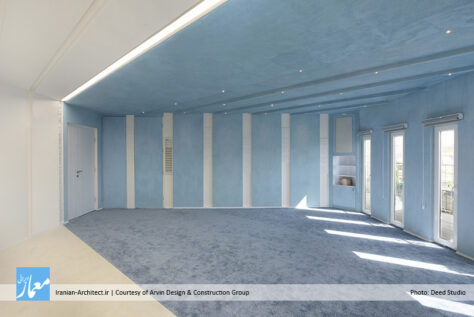
در طول فرایند اجرا نیز محدودیتهایی وجود داشت، از جمله اینکه ساختار صنعتی و جدارههای متشکل از ساندویچپانل در پروژه، محدودیتهایی در انتخاب پوشش جدارههای داخلی ایجاد میکرد که اثر مستقیم این عامل بر طراحی فضاها و عناصر داخلی، باید از ابتدا در نظر گرفته میشد. این در حالی است که وجود مصالح بنایی در جدارههای خارجی یک ساختمان باعث میشود که بتوان طیف گسترده از شیوههای اجرایی را برای پوشش جدارههای داخلی در نظر گرفت.
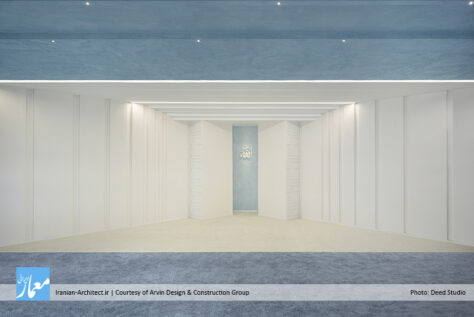
انتخاب مصالح، و رنگ و بافت آنها، متناسب با ماهیت هریک از فضاها صورت گرفت. از آنجا که هدف ما در طراحی نمازخانه، سادگی و خلوص در تمامی اجزای آن بود، به شکلی که تمرکز اصلی بر جهت قبله و موقعیت محراب باشد، از ترکیب رنگ آبی و سفید در این فضا استفاده شد که محیطی آرامشبخش را در زمان خلوت و عبادت روزانه، برای نمازگزاران مهیا میکند. تفکیک این دو رنگ با تضاد دلنشین خود در مجاورت محراب، و استفاده از ریتم و تکرار در الگوی هندسی این محدوده، موجب تمرکز بیشتر بر آن شد، و نیز امتداد این الگو در بازشوها و کاشت درختچهها در پسزمینه آن، حالوهوای زندهتری در فضا ایجاد کرد. همچنین جداره شمالی و اطراف محراب با آیات برجسته به خط بنایی، و با رنگ سفید و بافتی یکنواخت تکمیل شد. در سالن غذاخوری نیز انتخاب چوب و ترکیب آن با پسزمینه سفید و طوسی، گرمای خاصی به فضا بخشیده و محیطی صمیمی برای یک گپوگفت دوستانه در هنگام صرف غذا ایجاد کرده است. همچنین در فضای بیرونی و در بام، یک لایه پوشش گیاهی، شامل درختچه و گیاهان رونده، بهصورت یکپارچه و پیوسته، با داربستهای مشبک به ارتفاع ۱/۵ متر، برای بهبود چشمانداز تمامی جدارههای دارای بازشو تعریف شده است.
Break Area of Rahsazi & Omran Iran Company
Arvin Design & Construction Group (Elham Farokhi)
Location: Tehran, Iran
Date: 2021
Area: 200 sqm
Status: Completed
Client: Rahsazi & Omran Iran Company
Construction Manager: Naser Hashemi
Construction Team: Abolfazl Mohammadzadeh
Graphic: Fateme Ghanbari
Photo: Deed Studio
Each project is a unique quest for our young office, with its boundaries and definitions. Location and context, requirements, function, space and time constraints, budget, and many other specifications all have a direct impact on a project; But how to balance all the challenges and the objectives of our office as a designer and constructor, is always one of our main consideration in any project, and perhaps of all our projects, achieving a balance between project’s limitations and our office’s criteria is most evident in this project.
This break area is located on the sixth floor of the headquarters on Beheshti Street. This floor includes a dining hall and a prayer hall, each with a capacity of about 50 people, two toilets, a bathroom, a lobby, and a storage room. Client’s request for interior design and renovation of this area were an emphasis on enlivening the employees’ rest space, design in accordance with the organization’s chart, and the least amount of disruption in the work schedules of other floors and daily commutes, during the construction phase.
In the status quo, the prayer hall was located on north-end, and the dining hall was located on south-end. Considering the direction of Qibla and the access to prayer hall, resulted in a long undesirable corridor which occupied a large area. Also, the positioning of the dining hall on south-end which resulted in unfavorable views to the roof and mechanical facilities, and its distance from the dishwasher room also needed to be redesigned. Requirements such as two main accesses from the north and south to the roof, maintaining the required area for each space according to the design specifications, and access to the utility room, also imposed their restrictions. Therefore, the first step in design was the rearrangement of spaces: the spatial organization. By switching the locations of the prayer hall and dining hall, more suitable access to the prayer hall, and a more beautiful view towards the northern mountains of Tehran, was achieved in the dining hall. The entrance lobby, located next to the elevator, provided access to other spaces, with a more appropriate geometry, and a more favorable area. In the end, due to the spatial limitations, the toilet was placed in the middle of these two spaces, and adjacent to the prayer hall.
After the rearrangement, the necessary sub-spaces were defined according to the function of space. In the dining hall which there the food is served and not prepared, a small pantry was planned with small facilities for preparing food, a dishwasher, a hot counter, a refrigerator, and storage boxes. In the prayer hall, the shoe rack is placed separately, storage are removed from sight, and audio devices are considered to complete the requirement of this space. The previously existed automatic sliding doors was also reused in the design of the entrance to the dining room and bathroom, to reduce costs.
There were also limitations during the project construction phase. The presence of solid materials in the exterior walls of the building, makes a wide range of methods for covering the interior walls, but the industrial-designed structure and the sandwich panels placed restrictions on the choice of interior wall coverings. Thus, this direct effect on the design of spaces and interior elements should have been considered from the beginning.
The materials, their color and texture in each space, was selected according to the nature of the space. Our goal in designing the prayer hall was simplicity and purity in all its components, so that the main focus is on the direction of the Qibla and the position of the Mihrab. The combination of blue and white in the prayer hall, provides a relaxing environment for prayers, during contemplation and daily worship. Also, the separation of this two colors with its pleasant contrast in the vicinity of the Mihrab, and the use of rhythm and repetitive geometric pattern caused more focus on it. The extension of this pattern in the openings, and the planting of shrubs in the background, created a more lively atmosphere. The design of north wall encircling the Mihrab was completed with prominent verses, which done by masonry, in white color, and with a uniform texture. In the dining hall, deployment of wood and its combination on a white and gray background, has given a special warmth to the space, and has created an intimate environment for a friendly chat while eating. Finally, a green wall including shrubs and vines, was integrated continuously, with lattice scaffolding to a height of 1.5 meters, in the exterior of the building, and on the roof, to improve the view in all the walls with opening.

